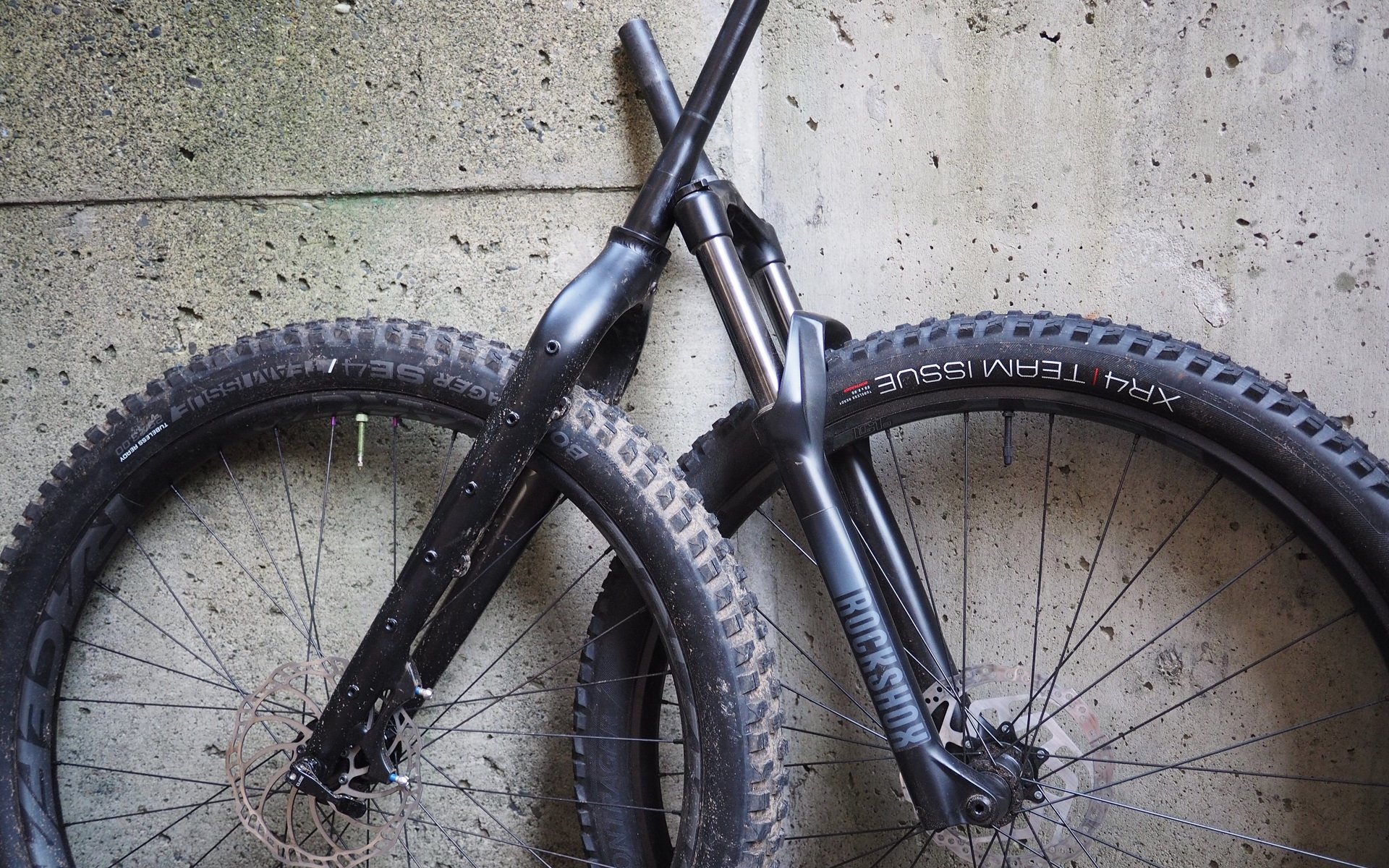
EDITORIAL
RockShox Recon VS RSD's Rigid Fork
There Need Be Only One
I'm prancing around my little workshop, singing along with The Coup, and celebrating the arrival of RSD's 510mm axle-to-crown rigid fork. This thing is huge, and here I'm not just talking about the legs. For rigid-curious folks, the potential here is massive.
What's the big deal? This fork is long enough, when sag is accounted for, to make it a friendly replacement for 29" suspension forks in the 130-150mm travel category, depending on tire size. That means rigid-curious mountain bikers can buy an off-the-shelf fork to experiment with their Honzo, Chameleon, Roscoe, Growler, Moxie, El Roy, a cheeky Chromag Stylus mullet, and really any number of rad hardtails.
Speaking of a cheeky Chromag Stylus mullet, throw a 29+ wheel and the RSD fork on any aggressive 27" or 27+ hardtail, and BOOM!
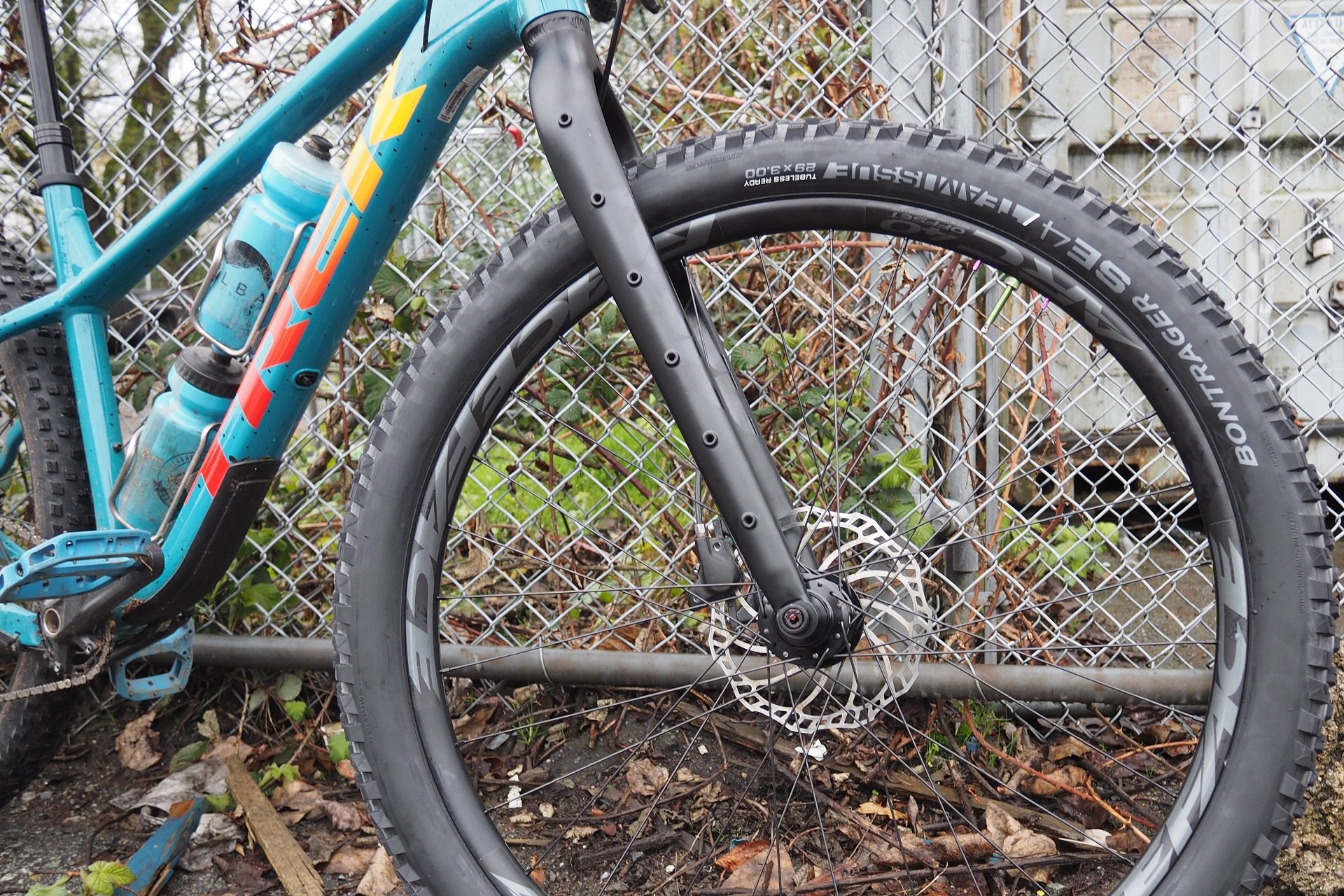
The 510mm axle-to-crown aluminum RSD rigid fork is a perfect swap for Roscoe's 140mm RockShox Recon.
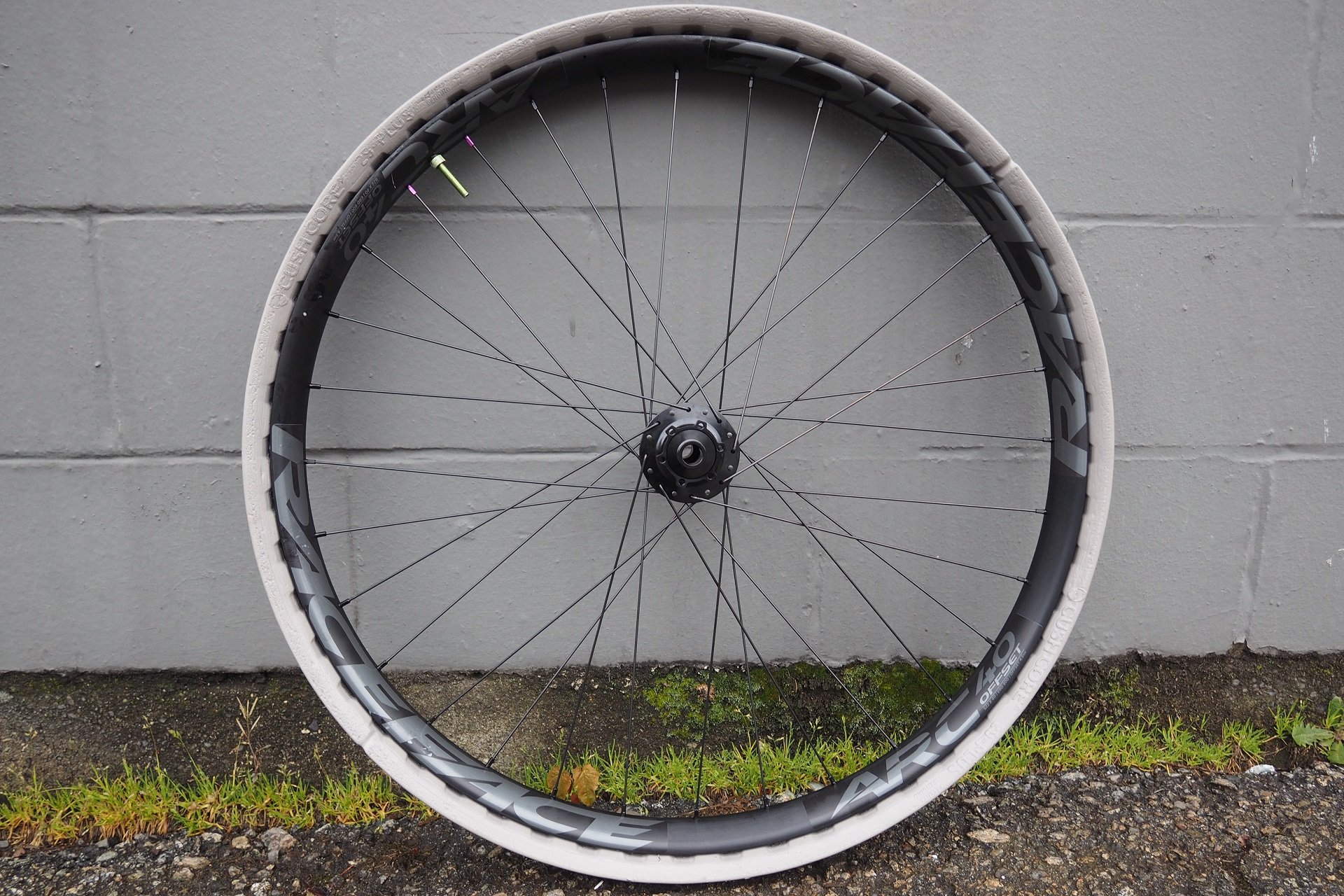
In addition to a full-on 3" Bontrager tire, a CushCore Plus insert is handling suspension duties.
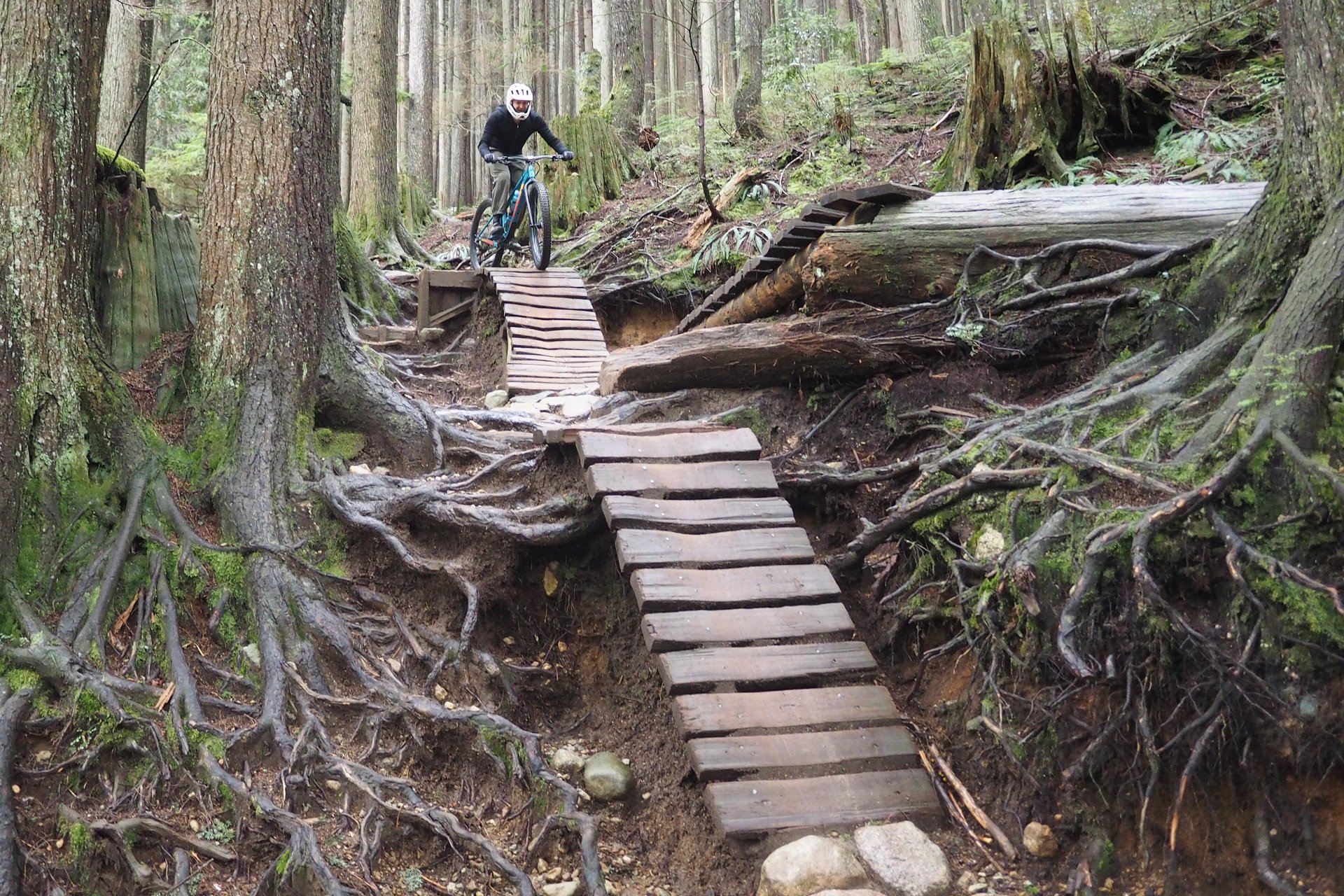
I ended up riding the same blue-to-black trails with both the rigid and Recon setups. Photo: The Clairebarian
With Bird no longer listing their 505mm axle-to-crown steel rigid fork, the aluminum RSD is the off-the-shelf option for a rigid fork this long, and that's okay. There really only needs to be one. Admittedly, I could do without the zits down each leg and I'd have chosen a fork offset in the 42-46mm range over the RSD's 51mm, but I'm not focussing on that shit.
At 350 CAD | 300 USD plus shipping (400 CAD | 345 USD) this is a perfect product for a rider looking to swap to a rigid fork for adventure rides, riding with a weaker rider, or simply experimenting with a rigid setup before committing to a custom fork.
Speaking to the intended use case, RSD only lists the fork with the 'adventure build' on their the Sergeant with a 27+ setup. Alex at RSD says that if someone looking at their more aggressive Middlechild wanted to go with a rigid build it would be easy to accommodate. You know, in the event anyone was checking out Arden's rad bike and thought they'd like one for themselves.
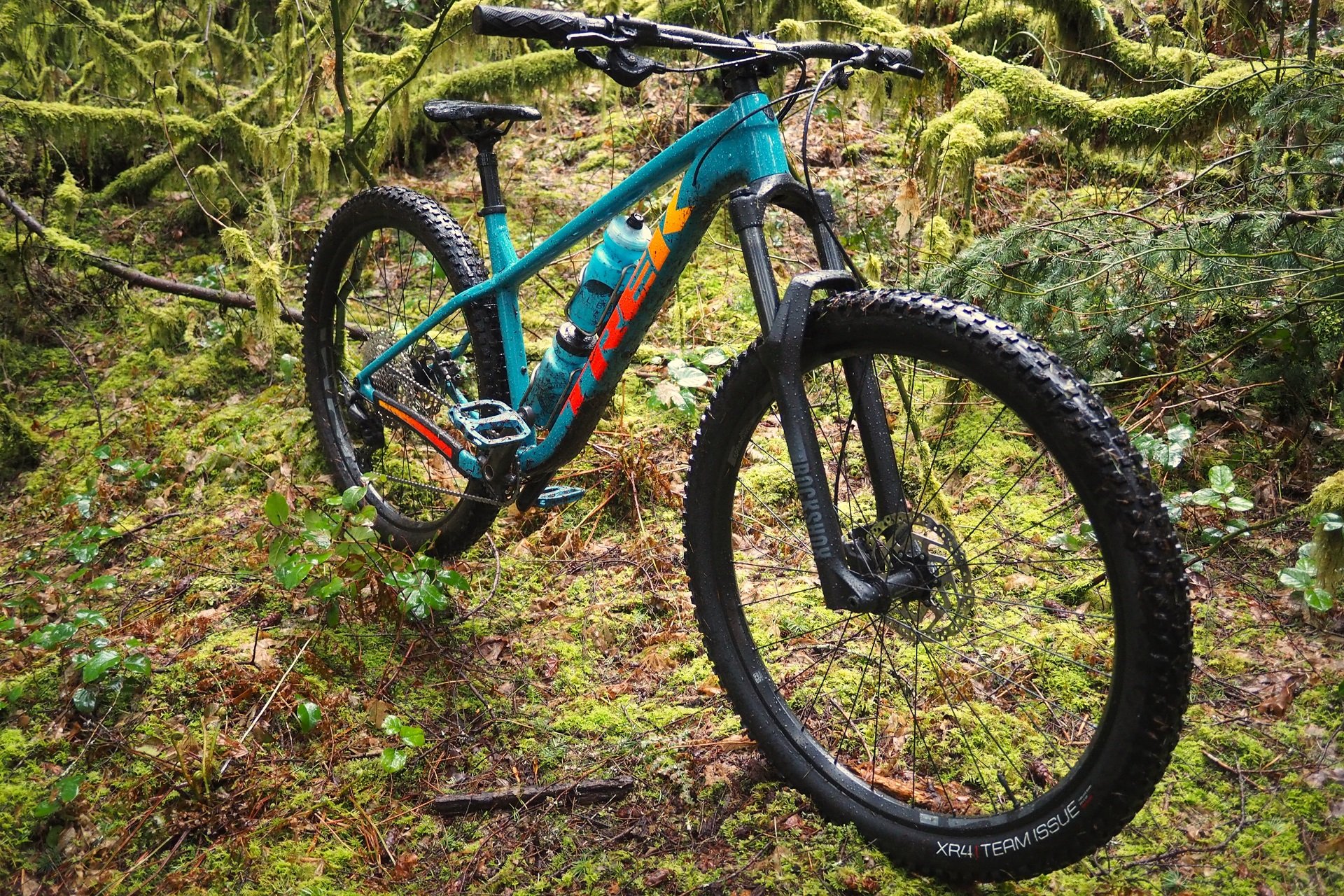
The Trek Roscoe 7 is a great-looking, high quality, mountain bike that's absolutely worthy of a future fork upgrade.

The aluminum RSD fork ties in nicely, and doesn't feel any more harsh than the steel forks I typically ride.
The Uptake
Everything just sort of came together. I'd just recently laced a brand new Race Face ARC 40 Offset rim to a Turbine front hub. My friend Will sold me the last new Bontrager 29x3" SE4 tire anywhere. I had a spare CushCore 29+ Insert. And, I'm reviewing a Trek Roscoe 7 that sells for 1650 USD (1880 CAD) with a basic RockShox Recon Silver TK suspension fork with a similarly patterned and rubbered, lighter casing, 29x2.6" XR4 tire.
The perfect opportunity to test something I've been saying for years; though consumers would never vote for it with their wallets, folks buying bikes under a certain price point could be better served by the lower weight and lower maintenance combination of a big-fat tire and a rigid fork compared to a basic suspension fork.
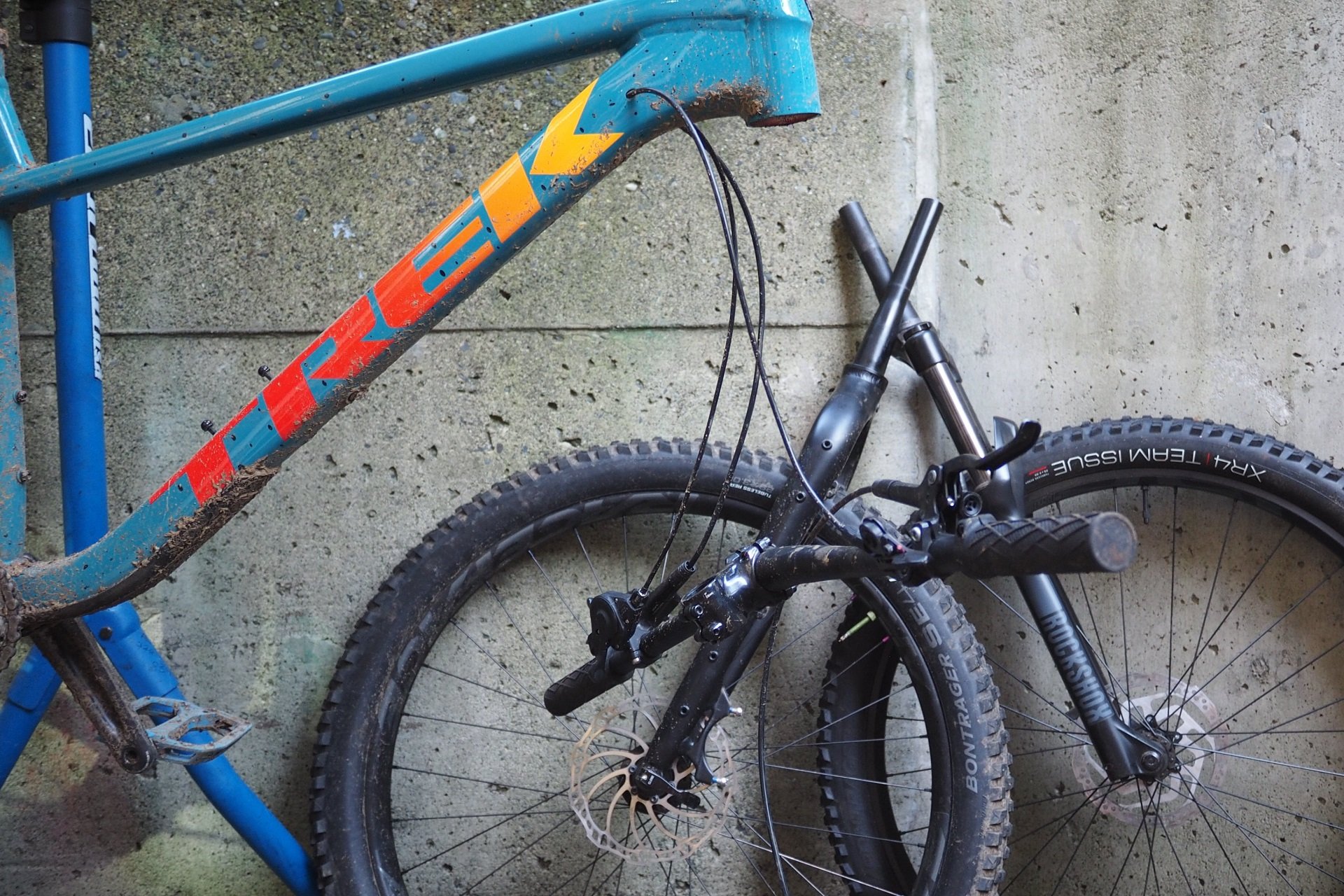
With a split crown race, it takes mere minutes to swap fork setups between the RSD rigid and the RockShox Recon.
I converted Roscoe's headset to a split-race for easy swapping and proceeded on a delightful journey of back-and-forth testing. In one corner, the basic 140mm fork with a good air spring and a damper where every 'click' of the rebound tab makes it feel like I'm breaking the fork. In the other corner, the 510mm RSD fork with my massive front tire.
I've actually been riding my own long-travel fork-equipped hardtail a bunch lately, I'm not all rigid forks all the time, but even so, I have to say that I love shredding the rigid-Roscoe. It's slower than descending my personal rigid bike and much slower than my personal hardtail, but comparing the rigid and suspended Roscoe it's closer to a draw.
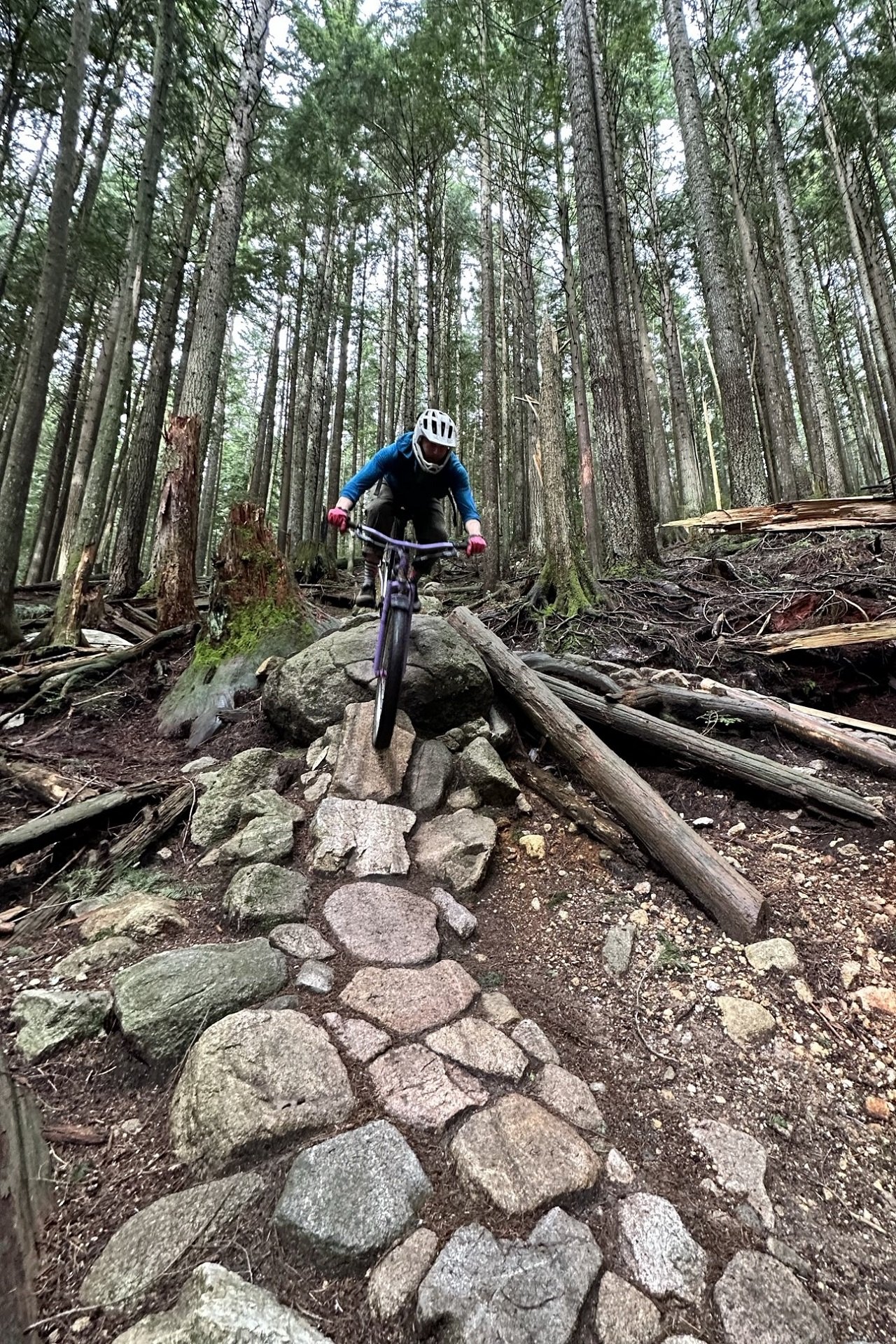
No, not the Roscoe 7. I haven't found myself quite this comfortable on it, mostly down to the basic brakes. Photo: Penny
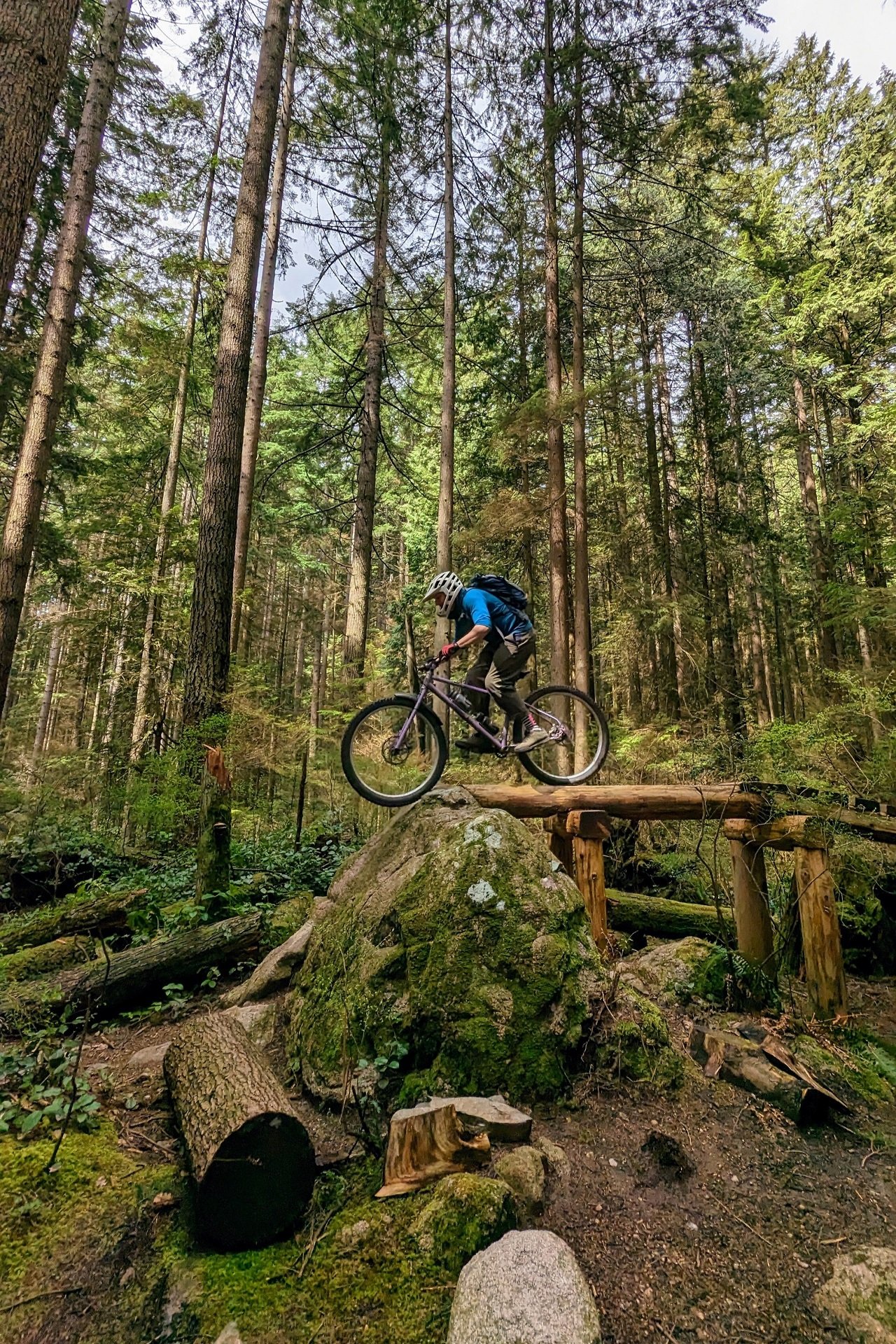
I just wanted to drop-in quick and mention that I understand why folks are derisive of rigid mountain bikes... Photo: JacAttack
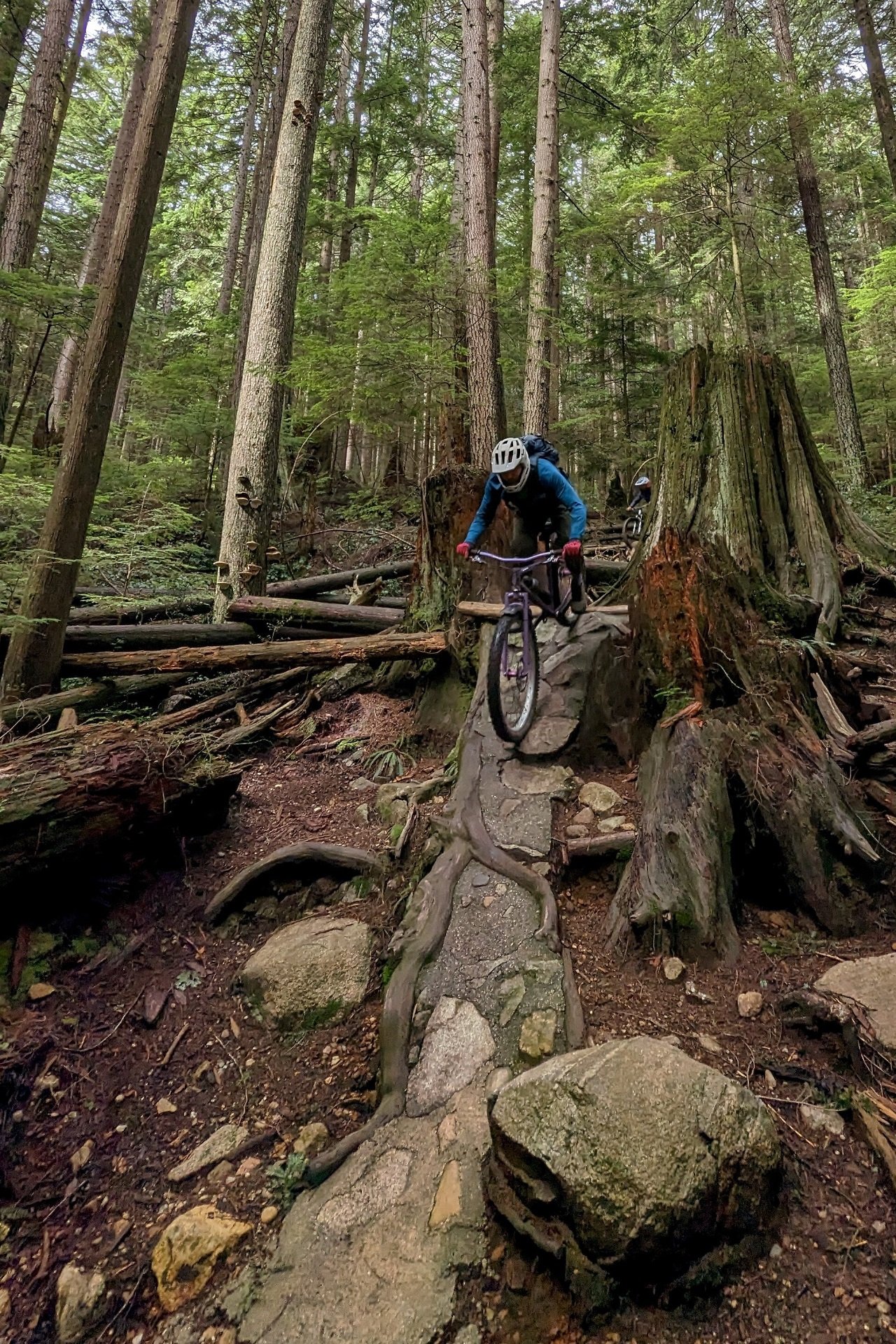
...even if they've never ridden a modern example. But, if you are rigid-curious, I am happy to answer any questions. Photo: JacAttack
The Let-Down
My family and I were headed out riding with my youngest brother and my nephew and my brother asked if he could borrow the Roscoe as it's a much better fit than his own bike. No problem, he's ridden it a couple of times before, but oh boy is he in for a surprise.
Brothers being brothers, I don't tell him that it currently has a rigid fork on the front and, as a truly casual mountain biker, he's the perfect guinea pig to test my rigid fork, Plus-tire equipped, budget-friendlier bike theory. And, to be fair, he was a good sport. And, to be honest, I was wrong.
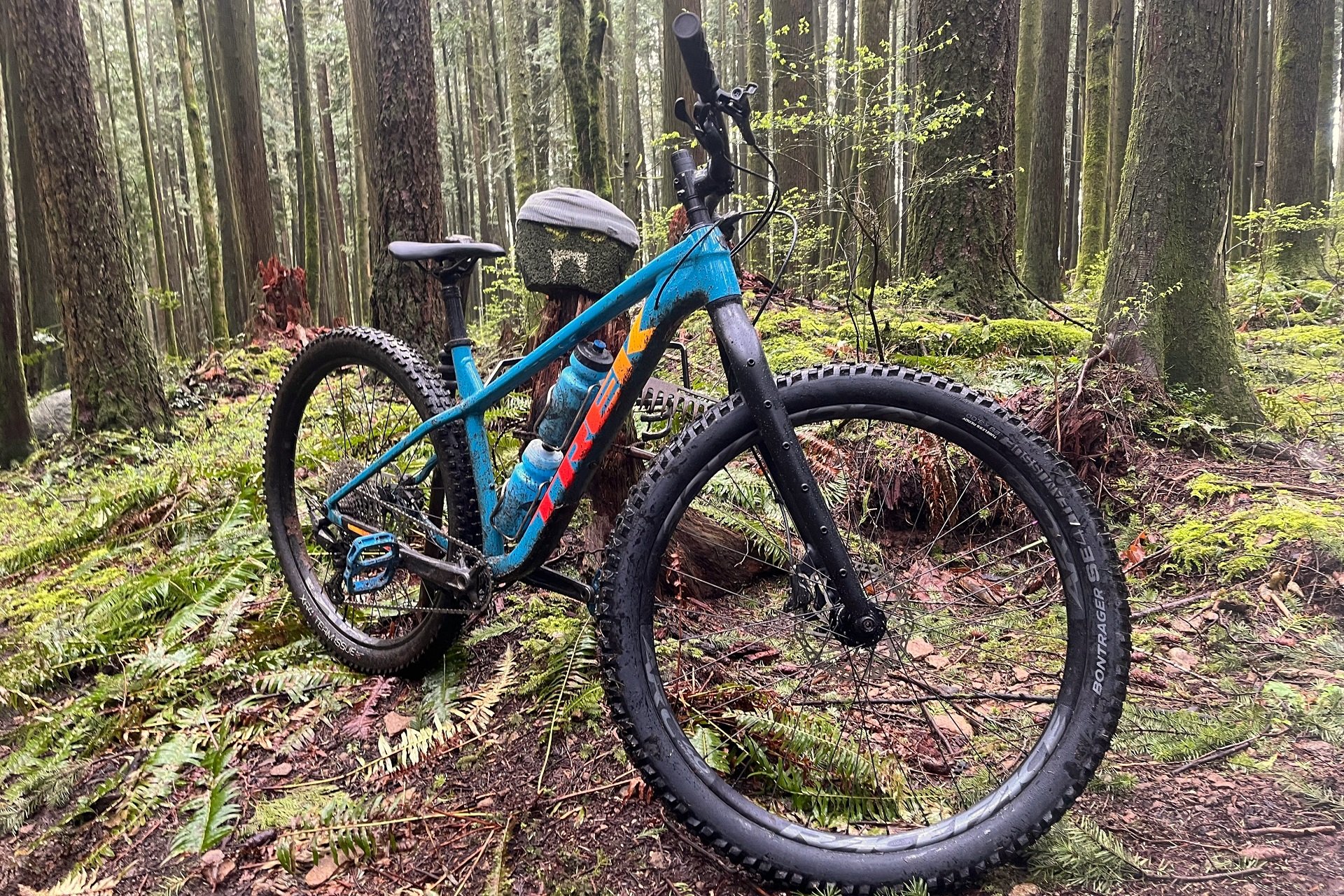
My youngest brother is a very casual mountain biker. Rigid vs. Recon made no difference to what features he rode when he borrowed the Roscoe.
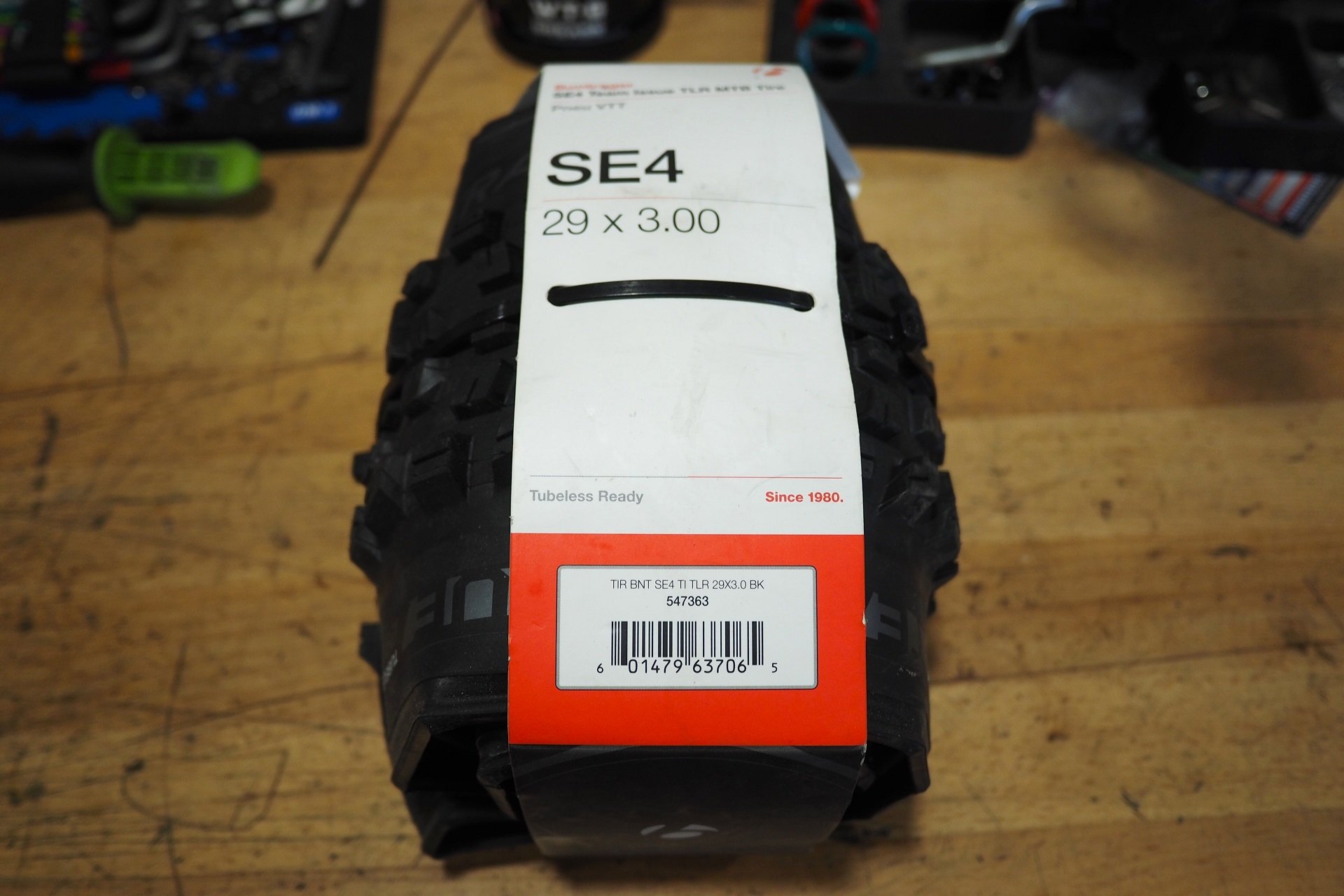
While I waxed poetic about the performance of the 3" SE4 and CushCore combination, he found the RockShox was more fun and more comfortable.
I love riding rigid mountain bikes, and all things being about equal, my RSD-Roscoe experience was a winner over Recon-Roscoe because it had a rigid front end. Folks who are rigid-curious, even as a sometimes-setup, will probably love it too. But for my brother, a casual mountain biker for whom a Roscoe 7 is as much bike as he'll ever need, the compromise in comfort and handling exactly at those moments when a suspension fork makes a difference was overt.
And yes, there are techniques to get the wheels to hook up in steeper low-traction situations, absorb bigger square hits, or pump through root gardens, without suspension but they're learned by putting in more hours than he's willing to invest. If the rigid fork is that much less fun and comfortable, so the money for a yearly service is easily justified, it's hard to argue in favour of the rigid setup. And being there to witness my brother riding on flowy blue trails, I’m certain most Roscoe riders will prefer the Recon.
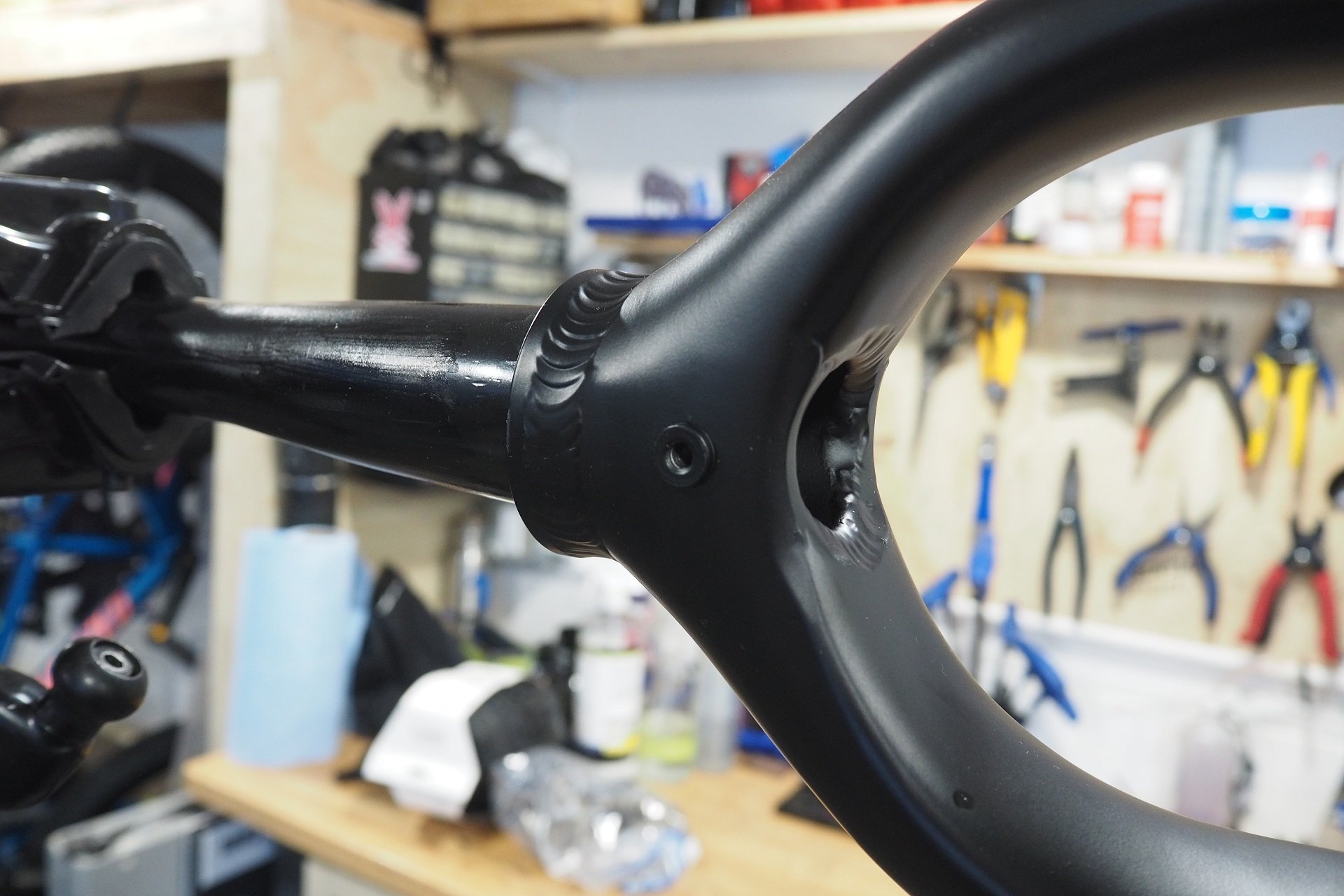
The RSD fork is aluminum but with the same rubber I don't find it anymore harsh than the steel forks I've ridden.
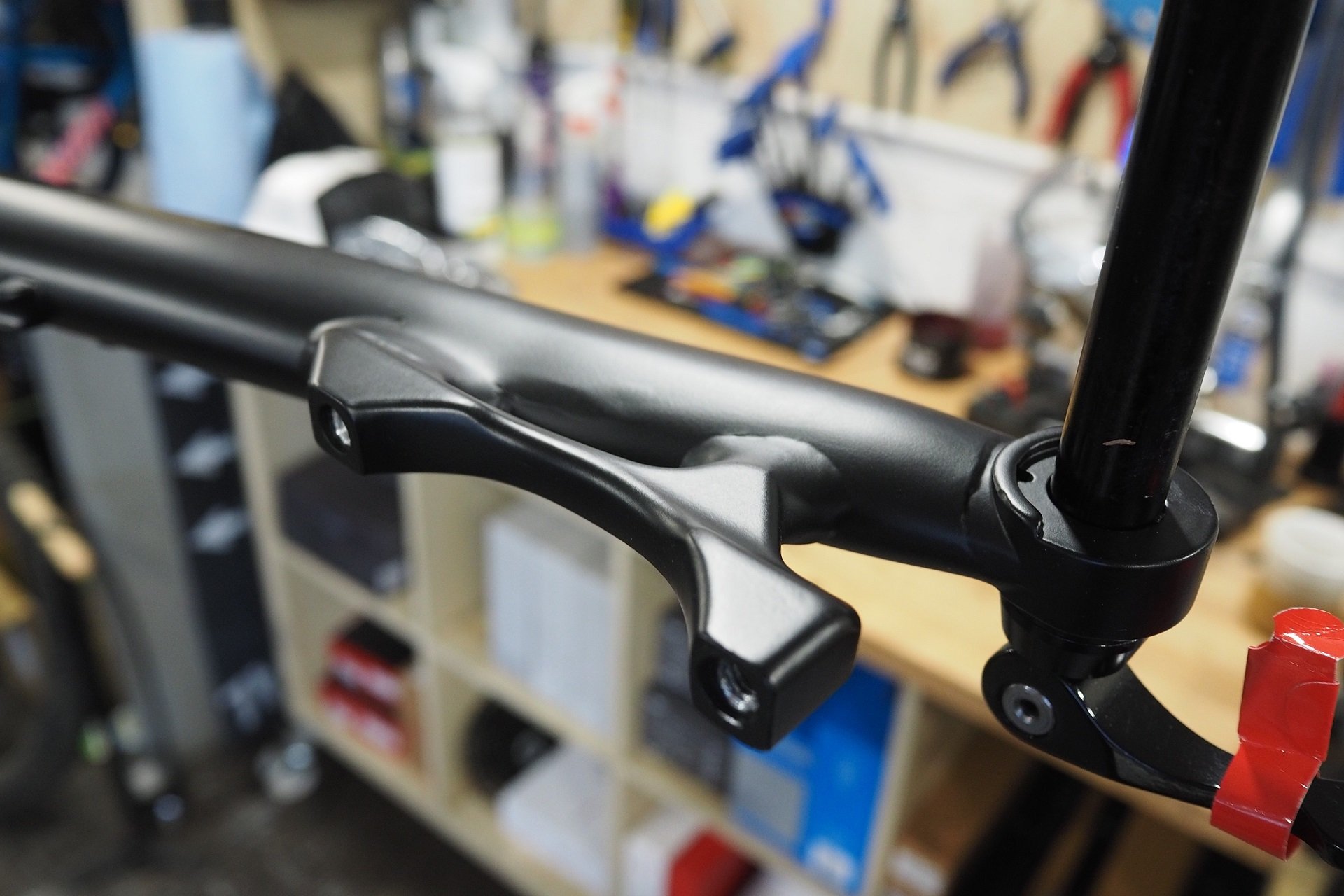
It has a Post Mount 180mm direct mount setup for brakes and alignment is good. I'd prefer a tool-required axle but had no issue with the QR.
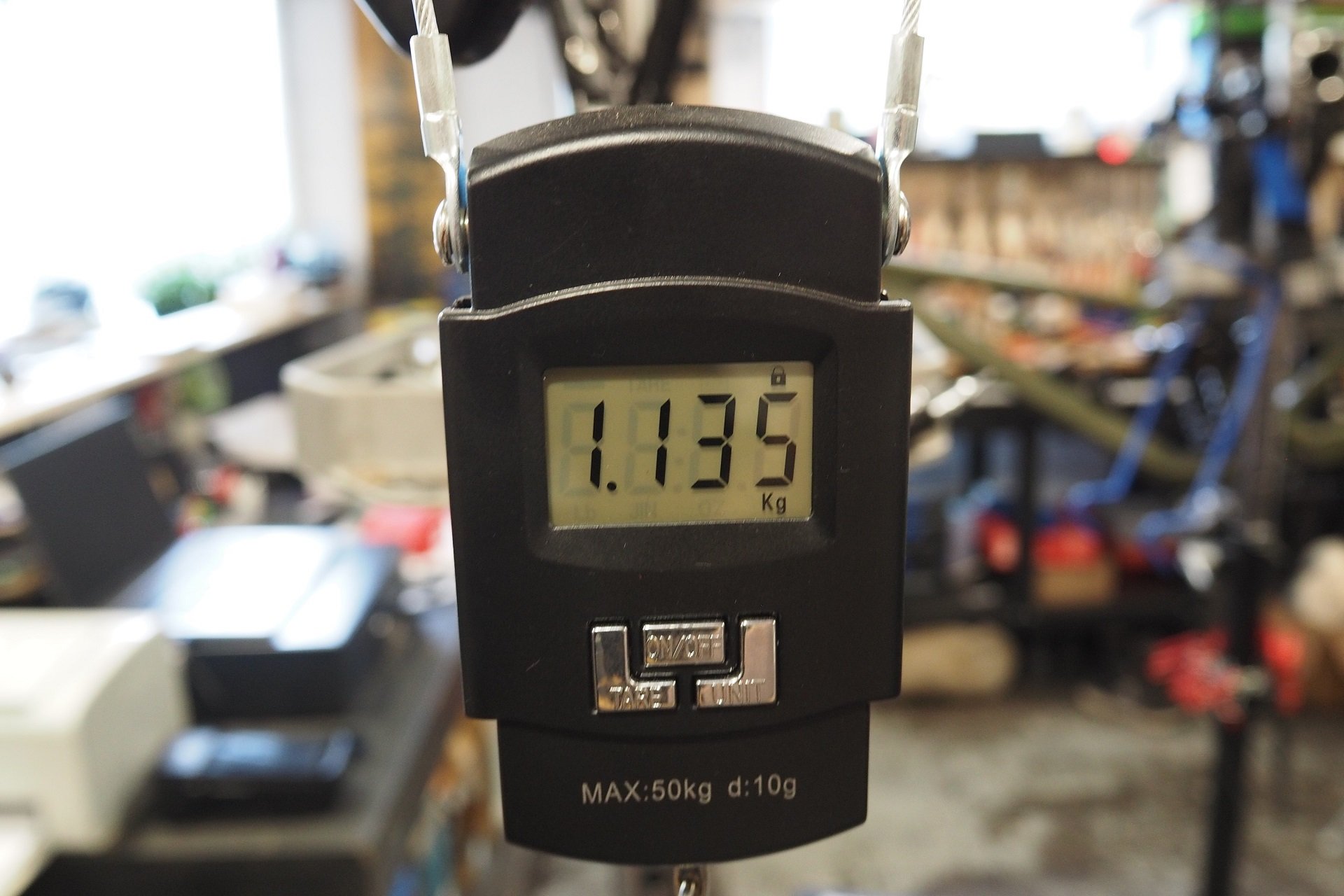
That's the fork and axle before I trimmed off 30-grams of steerer. The RSD fork, wheel, tire, and insert clocked in 615-grams lighter than the stock setup.
I'm giddy about the relatively inexpensive opportunity to experiment with a rigid setup on a slew of aggressive hardtails. I've already recommended the RSD to a number of riders as a starting point to riding a 'double hardtail' at least part-time.
But, you won't again hear me say that lower-end mountain bikes should come with rigid forks. The barrier to entry is buying a bike with a good-enough suspension fork, like the Recon Silver TK, but folks who want to hit trails will be best served to find a way to stretch into a bike like the Roscoe 7 for that reason.
For more information on the 1650 USD Trek Roscoe 7, in three colour options, please check out my first-look piece.
For more information on the 510mm axle-to-crown, 350 CAD | 300 USD rigid fork, please check out RSD Bikes.
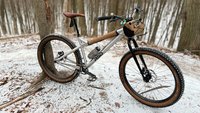
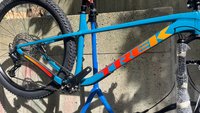

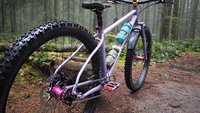







Comments
OldManBike
11 months, 4 weeks ago
Huh. Last week I thought the friction shifting paean was the Major-est piece possible, but now I’m not so sure.
Reply
Andrew Major
11 months, 4 weeks ago
Thank you for the word ‘paean,’ that’s a new one for me and I’m going to overuse the sh*t out of it.
———
I’d submit my combination hard sell on Rigid/#1FG to NSMB-contributor Ryan Walters and #JerryWillowsHatesMyBike troll attempt as the Major-est thing ever: Is North Shore Rigid Single Speeding For You? (for Ryan)
But 2018’s The Best Bike In The World is still the best thing I’ve put together by a mile.
Reply
Andy Eunson
11 months, 4 weeks ago
Rumour has it Andrew’s gonna test a pair of 1983 NOS Nike Lava Dome shoes with toe clips and straps next.
Reply
Andrew Major
11 months, 4 weeks ago
Haha. I did try toe clips once before I bought clipless pedals.
After two decades of predominantly clipping in I don’t see myself going off flat pedals.
Reply
taprider
11 months, 3 weeks ago
"Haha. I did try toe clips once before I bought clipless pedals."
That's the problem - you only tried toe clips once
For those of us that started with toe clips around age 11, it became instinctive.
The rare times I am back on my road bike, I sometimes catch myself reaching down to my foot to loosen the straps before a stop sign, even though I haven't used toe clips since the 1990s. I also sometimes catch myself reaching down to the down tube for the phantom friction shifters.
Reply
Bli33ard
10 months, 1 week ago
Toe clips or SPUDs since 1978- your feet belong on the pedals, end of story.
Reply
Jerry Willows
11 months, 3 weeks ago
almost 70 comments on a rigid fork (I know the irony).... world has gone mad. Stupid gravel bikes even have suspension now.
Reply
Andrew Major
11 months, 3 weeks ago
Jerry I could survive for days on the sweet, sweet nectar of your disdain alone. I create this content first for you, and then for everyone else.
#JerryWillowsHatesMyBike and #JerryWillowsCouldHateYourBikeToo
Reply
Jerry Willows
11 months, 3 weeks ago
we need an opt out feature like PB does for ebikes... you've amassed quite a cult.
Reply
Andrew Major
11 months, 3 weeks ago
There’s a photo of a rigid fork in the title image AND the word ‘rigid’ in the title. I mean, how much more of a warning label do you need to avoid it?!
‘Surgeon General’s Warning - Rigid North Shore Riding Content Requires Incredible Force Of Will To Resist.’
———
Also, you can read about the 160-180mm carbon super-sled du jour an infinite number of places on the internet, including with a North Shore bent here at NSMB.com.
Is it really that big a deal that folks want to read about, and maybe even try different stuff?
Reply
ackshunW
11 months, 4 weeks ago
Does this “Rockshox” fork outperform a standard rigid front end? Head to head shootout inside! We compare performance on the climbs, the downs, and tech! Spoiler! The winner might surprise you..
—April 1993 issue, North Shore Mountain Bike Action
Reply
Andrew Major
11 months, 4 weeks ago
Hahahaha. I totally had this in my mind when I started writing this (with a monster-truck announcer voice) but wasn’t bold enough to go full-hyperbole.
Hopefully it doesn’t read anything like that…
Reply
Lu Kz
11 months, 4 weeks ago
I actually recall Trek selling a fully rigid trail bike in fairly recent memory: a few years of Stache 5 came with a 120mm rigid suspension corrected front fork. I do not recall being able to convince our owners to order one for the floor.
Here you're comparing a recon, a budget fork, but a budget fork that actually does what it says on the tin, with a rigid fork. I wonder if your observations about your brother would change if you observed him getting off the rigid bike and immediately on a most basic trail hardtail with one of those steel stanchioned boat anchors that don't always do the whole suspension thing.
Reply
Andrew Major
11 months, 4 weeks ago
I’ll talk about this more in my Roscoe 7 review but I’m approaching budget bikes with a certain minimum spec these days. The Recon is a good budget fork.
My brother rode the Marin SQ I reviewed with the basic coil Suntour and at his weight it still moves a lot more than a rigid. I come from this as a lover of rigid forks, but at the price point of a bike I can see someone buying to mountain bike locally it’s probably going to have a Recon Silver at least?
Reply
Blofeld
11 months, 4 weeks ago
For anyone else playing Geometry: The Home Game - static geometry on the Roscoe after the fork swap should be a bit under 2° steeper, BB is 13mm lower and the reach (if you believe in such things) is 20mm longer. IIRC the popular hardtails mentioned as being more capable would have an additional 4” of wheelbase compared to li’l rigid Roscoe.
Since such numerology is conspicuously absent in this article, I suspect more alterations are forthcoming. I hope further fraternal trickery is planned as well. If I had to offer a suggestion for the latter, it would be to find out how sideways an angleset install can get before it’s noticed.
Reply
Andrew Major
11 months, 4 weeks ago
I started down a rabbit hole with numbers. Roscoe at 20% sag, Roscoe at 25% sag, Roscoe at 50% sag (closer to where the Recon actually sits when dropping into properly steep North Shore jank). Then ground-to-crown measurements since the 3" SE4 is taller than the 2.6" XR4, but then what about tire sag? Then I got bored and decided it didn't really matter.
This RSD fork is mine for a different project, I just had a very powerful desire to put it on the front of the Roscoe, and every other budget hardtail I have the opportunity to review this year.
Reply
Blofeld
11 months, 4 weeks ago
The proper sag for a hardtail’s geometry assessment and the best bike to make into a rigid are both great topics. I look forward to reading more!
Bouncing between the two topics I end up fixating on the BB drop. Anything lower than 75mm would be annoying for me, even on 29+ tires. This seems like less of an issue for descending (as in the 50% sag case) since jumping and/or not pedalling is an option.
Reply
SiT
11 months, 4 weeks ago
Great article Andrew, just my cup of tea.
On the subject of Bird (great bike brand btw) here was my rigid experiment with a Whisky No9 Boost LT (custom painted to match the Bird Zero29 frame) as at the time could not get RSD or Trek 1120 and Bird had not started selling their own fork - was a sort of 'gravel bike' experiment. did also have drop bars on it for a while - just to see.
Reply
Velocipedestrian
11 months, 4 weeks ago
Looks like a hoot!
Reply
Andrew Major
11 months, 4 weeks ago
Fun looking rig!
Did you ever set it up with Plus rubber and take it on janky trails? Lots of room in the front.
Reply
TristanC
11 months, 4 weeks ago
I'm a little puzzled by the $300 price tag. Maybe I'm still estimating prices pre-inflation, but I would expect a rigid not-plastic fork to come in around $150 max? Surly forks (not as long at 483mm, steel boat anchors) are $175, and I bought a whole Stooge frame and fork for $800 new.
Re: not price whinging, I started riding on a rigid 27.5+ (Marin Pine Mountain) and it has definitely influenced my bike choices since then. I happily ride everything on a hardtail and switch between rigid and squishy forks regularly. I've also done a 26x4.8" up front and a 29x2.6" out back, rigid, which is much more fun than it should be.
Speaking of plus tires on rigids. Am I going to die if I put a 3.25" Duro Crux on an i30 rim?
Reply
Andrew Major
11 months, 4 weeks ago
I don’t know what it costs to get a small batch of limited production aluminum rigid forks made. But a couple of thoughts.
1) RSD is a small brand with nowhere near QBP/Surly’s purchasing power or financial clout.
2) There are zero other similar products in the market so there’s no standard bike industry R&D here.
3) Looking at the prices of RSD’s other products (frames and completes) everything else looks comparatively reasonable, so I think it it would be fairest to assume if there were competing products they’d be similarly priced.
4) Available right now and cheaper than custom.
5) It’s actually the only off the shelf option available that would work with a lot of hardtails.
———
Re. Tire/Rim. It gets very, very pressure sensitive and I think you’d have a better experience with an i40 but I did play with this for science in 2017 to see if Mavic’s claims that 3”/i28 worked would pass the trail test and it was okay.
Article here if you’re interested.
Reply
mikeynets
11 months, 4 weeks ago
I know it's 10mm shorter — and carbon, and $200 USD more — but the Whisky No. 9 Boost Lt fork is similar in intent and function.
I've swapped it back and forth with a 130mm Pike on a Cotic SolarisMax.
Yep, it changes the HA a bit and yep, it's a different experience. But enjoyable and rideable in both guises on the same trails. But isn't that the whole point of component changes?
Reply
Andrew Major
11 months, 4 weeks ago
That 10mm extra static height makes a big difference in terms of what bikes it opens up to rigid experimentation, but the Whisky could be a good option in the 120-130mm hardtail range.
Can always buy a tall crown race too if it’s a bit on the short side.
I don’t care much about grams, so I admit that, being carbon, it wasn’t on my radar as a tall-rigid option.
Reply
Kenny
11 months, 4 weeks ago
A better comparison is the trek 1120 adventure fork.
510mm axle to crown, carbon legs and aluminum steerer (a very practical compromise IMO) as tons of mounts, retailing at 400 USD.
I bought one but put it up for sale after a few rides, the rigid thing is just not for me. I still think the fork is the hot ticket for rigid setups if a balance of weight vs cost is a consideration.
Reply
Andrew Major
11 months, 4 weeks ago
The 1120 fork doesn't include an axle in the price (400 USD / 530 CAD + axle) but it's a great-looking option in a 510mm axle-to-crown length for those that would be happy with a carbon option.
Vik Banerjee
11 months, 4 weeks ago
Ya. I've been surprised by the $$ cost of that RSD fork when I have looked at it. The Bird steel fork was $205CAD shipped from UK to BC. I'm hopeful that fork comes back. Bird has long periods of zero stock on frames so perhaps the forks are just on pause until they get production sorted?
Reply
Lynx .
11 months, 4 weeks ago
Hey TristanC, yeah, I'm with Andrew on this one, IMHO you want at minimum an i35 rim, but preferably an i40-45 if you're going to run that wide a tyre. From my experimentation, my rules go like this 2.2-2.4" = i25-i30, 2.4-2.6"=i30-i35, 2.8-3.0"=i35-i40. If you're running an FS, where the need for cush isn't as important as grip, then you can run wider rims, like 2.6" on i40, but going for something 3-3.25" on an i30 rim, you'd need to run the pressures too high and still would get tyre roll IMHO.
This is from someone who enjoys a short travel FS and rigid, all on the same technical, steep trails. My FS setup is i25 R/i30 F with 2.3" tyres because I found in a certain spot, on a few trails the sidewall was too exposed and getting punctures below the rim seat bead line in the back on i30, switching to i25 solved the problem. I run my current Conti RUBAN 2.6" on my i35 wheelset, but did try them on my i39 set and found that they had too much support and were much harsher.
Reply
TristanC
11 months, 4 weeks ago
Yeah, thinking on it some more, I should do a tire rotation. I've got i40s on my fat bike summer wheelset, so I should put a 3.25" on there, then take the 2.6" from that and put it on my Stooge with i30s, replacing the 2.35" I've got there. I should really also put an insert in the back of the Stooge because I ride that bike like an idiot.
Reply
Hank D
11 months, 4 weeks ago
I also started mountain biking on a rigid Pine Mountain. I rode it like that for about 4 years and just swapped the rigid fork out for a Recon about a year ago. It totally changed the way I ride the bike. I can’t imagine going back. I get enough of a taste when I take my gravel bike down the local trails.
That being said it was a great buy to get a really fun, bomb proof steel bike with decent components for only about $1,000.
Reply
Andrew Major
11 months, 4 weeks ago
What size tire were you riding up front? For technical terrain the rigid setup really doesn’t work without the big rubber.
That said, the Recon is a good little fork. Enjoy!
Reply
Hank D
11 months, 3 weeks ago
I was running 2.8 inch Maxxis Rekons. They did a pretty decent job eating up roots and rocks. I didn’t have a gravel bike when I got the Pine Mountain. I used it as a do-it-all off road bike. The 2.8 tires provided a good balance for that.
Reply
Andrew Major
11 months, 3 weeks ago
Cool, 2.8” Rekon is a great do it all choice. Are you still running big tires with the Recon up front?
Reply
Hank D
11 months, 3 weeks ago
I went down to the 2.6 Rekons when I got the suspension fork. I’ve thought about going slightly smaller but I think they’re just about right for the 27.5 wheels
Bikeryder85
11 months, 4 weeks ago
Great and timely write-up Andrew! I have been hem-hawing over this very question for the bike I am building for my wife (novice). My grom has progressed a ton on a rigid & plus set-up, so was curious which way to go for the Mrs. I think you have answered my question. My bike on the other hand......
Great job! You should use your brother as a guinea pig more often!
Reply
Andrew Major
11 months, 4 weeks ago
Cheers. Yeah, it’s a tale of two brothers. Clearly the rigid fork was rideable but much less enjoyable for my youngest brother (UTS) but I’m now trying to convince my brother who does ride regularly (CTK) to let me put it on the front of his single-speed Honzo for a couple weeks.
CTK just rolls his eyes but I suspect he’d actually enjoy the extra challenge in the blue trails near his place that he uses all the time for ride from home rides. If only to spice things up.
———
My wife loves her hardtail. Especially being short it allows for a long dropper post and the plus tires add a lot of comfort. The mistake I made (have been making) was basing tire pressure off of what I would run sans inserts (I don’t run CushCore in her tires).
Lately I’ve been dropping the pressure in an effort to tease out how low us too low.
But yeah, she’s running a 140mm suspension fork and that’s perfect.
Reply
Dogl0rd
11 months, 4 weeks ago
Next, review it on a fully :)
Reply
Andrew Major
11 months, 4 weeks ago
Maybe Cane Creek will send out a flex-stem to review and I can turn my Rifty into a 120mm Proflex?!?!
Reply
JT
11 months, 4 weeks ago
I enjoy the transition times of year where I convert my Sarge between the 29" or fat set up (season dependent) where I have the rigid fork on for a few rides, though my wrists generally give me a no-go after a few hours. I also like dorking around and rolling the fat out back with the squishy fork and 29er up front. Frankenbiking is a good way to figure out things. But I've raved enough about my RSD experiences. No one needs to read em anymore.
Sus on entry level bikes is always suspect. Some are better than others, but get to a certain price and it really is just to have one on there, regardless of performance. And that takes away from other bits that could be upspecced and provide a real performance advantage. Admittedly, this is coming from a more than mild enthusiast's perspective. There are great skills to be picked up riding rigid. Seeing my pal who's built like an ox ride through a rock garden at a clip on his old Fisher Rig, flitting along like a ballerina, really drove home that learning to ride rigid well makes going back to a full sus a helluvalot faster. Hunch is the newbie coming into the sport won't appreciate that aspect though.
Reply
Andrew Major
11 months, 4 weeks ago
I’m deducting 5000-points for not including photos with this post! (Nb. points have zero value).
“Frankenbiking is a good way to figure out things”
Yes. Although usually I see Fat-front / Plus-rear so I’m curious to see/hear about your setup?!
Reply
JT
11 months, 4 weeks ago
The stock SunRingle Duroc 50 rear wheel fitted with a 4" tire, 9psi for hardpack, the Mattoc set to 150mm, 29x2.5 DHF. It corners and climbs so stupidly good you have to giggle. Like riding a softtail that is actually soft but has more traction than one person should ever need. That and it looks soooo comically ridiculous, something straight out of a Rat Fink comic. It's the antithesis to the seriousness of my full susser.
Reply
Andrew Major
11 months, 4 weeks ago
Sounds amazing!
Reply
JT
11 months, 3 weeks ago
Reply
steelispossiblyreal
11 months, 3 weeks ago
Whoa. Now you convinced me to try this 3.8" Hodag (more like 3.6") on a 27.5" Hugo with the 29x3.25" Duro Crux up front. Should be a wild ride. Only about a 12mm difference between front and rear tire width.
Andrew Major
11 months, 3 weeks ago
Your images aren't showing (privacy issues?) if you want to send them to me I'll post them.
cheapondirt
11 months, 4 weeks ago
Too bad; I was rooting for the underdog.
You continue to pique my interest in rigid bikes. One of these years maybe.
Reply
Andrew Major
11 months, 4 weeks ago
The real underdog is me trying to tickle the interest in experienced riders for riding modern rigid bikes on aggressive terrain.
“One of these years maybe” is a win. But don’t tell Cooper I was evangelizing.
Reply
Cooper Quinn
11 months, 3 weeks ago
👀👀
Reply
BadNudes
11 months, 3 weeks ago
I had been waiting for this for over a year I think? Thanks for following through!
I got my hands on one of these recently and it seems decent. Not terribly stoked on the axle setup; I like a QR but I've already spent too much time looking for the loose nut under my work bench and in the gravel parking lot. I'd much prefer a captive nut but I like the versatility and simplicity.
Funny you mention a Stylus - going to experiment with the RSD fork on mine next, mainly just so I can have one bike with Al frame/steel fork and one exact opposite, and because a matching RSD frame & fork feels too obvious.
Reply
Andrew Major
11 months, 3 weeks ago
I like having the threads separate from the fork. Sure, there are the more elegant way other companies have done it - like Fox with their insert - but the RSD solution has grown on me.
Post pics of the Stylus and let us know how it is!
Reply
steelispossiblyreal
11 months, 3 weeks ago
I sold my Canfield Nimble 9 hardtail to get a REEB Donkadonk setup year round rigid and it's been so much fun. Currently running it with a 29x3" Ranger in the back and 29x3.25" Duro Crux up front, no Cushcore (even though I love Cushcore). It really is such a great change of pace to my Starling Murmur, but I really do need to remind myself what I'm riding when I drop down the first descent. Or, put differently, the trail reminds me pretty quickly. It's been nice to have a bike that forces me to dial it back a bit since I've been known to blow myself up on the downhills.
I've got it with a Kona Woo fork, which has 150mm (fat) spacing and a wopping 515mm A2C. And it feels sooooooo good. If anything I could go a little slacker in the summer, but in the snow it's goldilocks.
Reply
Andrew Major
11 months, 3 weeks ago
The REEB looks great - the Kona fork ties in nicely.
Have you ridden any other proper 29+ tires? Jones Bikes has those 3.25 Duro tires in a tubeless ready casing now and I’m curious how they compare on trail. What’s your internal rim width?
I love the 2.8” Vigilante in Light/HighGrip but I’m on my last one so hoarding it for next winter while hoping they make more.
In the meantime I bought a couple NOS SE4 tires in 3” and they are pretty big, but not 3.25”. I’m running the SE4 tire on i40 rims and would entertain that i45 is better.
Reply
steelispossiblyreal
11 months, 3 weeks ago
Thanks man. I couldn't believe how well the Kona fork color matched. Dr. Welby sold that to me for a song. Speaking of Dr. Welby, I've got some 50mm Alexrims that he sent me a link to, I believe they were like $30 USD per hoop?
These are the only 29x2.8"+ tires I've tried really. I've got a 3" XR4 in the tire bin just in case the Duro Crux didn't work out. But the Duro Crux seated up tubeless no problem with no leakage/seapage despite being an older one. My buddy got the newer Duro Crux and it definitely feels less supple / more damped. I'd like to A/B, but I'm sure Cushcore in this lighter older Duro Crux is plenty.
One day maybe I'll try an Oddity Squidfork on this thing because plastic is existentially scary. But this Kona fork, especially for the price, is basically impossible to beat.
Reply
Marc Pfister
11 months, 2 weeks ago
Lacing up some summer wheels for arroyo honking I was shocked and stoked to discover that a Vee Snowball on an i45 rim is only 3.3" wide.
The fat bike frame it's going on has pretty progressive geo so it runs "tail heavy". I'm interested to see how a little more floatation in the back will work in sandy sections
Reply
Andrew Major
11 months, 2 weeks ago
Definitely post some pictures of the setup when it's done!
Reply
Marc Pfister
11 months, 2 weeks ago
Here it is in half-half-fat mode (quarter fat?). I would say it's a net plus a quarter of the time, the rest of the time it feels out of balance.
BC_Nuggets
11 months, 4 weeks ago
"I love riding rigid mountain bikers" -- interesting kink you've got there sir. (Yeah I like a good typo.)
Reply
Andrew Major
11 months, 4 weeks ago
Hahahaha. I wouldn’t be surprised if the editor noticed that too and left it in (who doesn’t love a hood typo?) hahahaha.
Fixed now - thanks!
Reply
SteveR
11 months, 4 weeks ago
One of two timely articles this week, Andrew, as I consider next winter’s complete make-over of my 2000 Dekerf Team. Currently it’s setup with 35 mm tires and an ancient Reba fork, seeing duty as my “gravel” bike. My vision is rigid fork, 27 wheels and wider rubber (it will take up to 2.1) Stumbling block thus far has been the fork- big bucks for a piece of Dekerf artwork, or something from the likes of Surly (heavier and ugly as f with all those warts)? It has to be 11/8 so any other suggestions? Second timely article was about the pedals, as on our first ride with the 7 year old granddaughter on Sunday, her foot slipped off the cheap stock not-very-grippy pedal on her Spawn (bought by us!). Ouch! As a mostly clip less rider myself, the switch to flats with all those spikes for winter does give me pause, and I have been maimed a time or two. My idea with the One-ups might be to grind the “safety nuts” down somewhat to expose the pin a bit? The trails that we ride with the kid tend to be smooth dry nontechnical dirt and not NS style ( kudos to Claire!) Thoughts?
Reply
Andrew Major
11 months, 4 weeks ago
Hi Steve,
Rather than ground down the safety nuts and end up with a pyramidal pin shape I'd run the standard (short) nuts with washers behind the heads of the pins to lower them.
When Claire was first learning to ride flats (she's been on the Radar's since she was about 4) I had her in some cheap soccer shin pads but what really did the job was my elbow pads. Great to pedal in and long enough to take all the hits.
I've never found elbow pads that I love, so I almost never wear them, so it was really nice to dual-purpose them.
Reply
Andrew Major
11 months, 4 weeks ago
For a rigid fork, what sort of axle crown number are you looking for? (How much travel does your ancient 26" Reba have?)
I'd check out the Surly Lowside. It has no warts, just the right classic bend to the legs, and a 420mm axle to crown should be pretty compatible with most 26" hardtails especially if you're installing a bigger tire.
Reply
Velocipedestrian
11 months, 4 weeks ago
My 26" Trailstar has a Karate Monkey fork
It feels pretty equivalent to a 100mm set up firm.
Reply
SteveR
11 months, 3 weeks ago
Call me vain, but I have a hard time getting past all those warts!
Reply
JT
11 months, 3 weeks ago
Been contemplating getting a buncha spikes ala leather jackets to run up and down the legs on mine. Punker than thou and all. Problem is I'm pretty sure that would just somehow end up with me landing on em the next time I crash.
Reply
Velocipedestrian
11 months, 3 weeks ago
Silicone spikes? Look dangerous but aren't?
SteveR
11 months, 3 weeks ago
Thanks Andrew! Somehow I missed that fork on a quick browse of the Surly offerings. Although a Dekerf fork tugs at the emotional heartstrings, the Lowside looks like the practical choice. Current unsagged axle to crown on the 100 mm Reba is 465, which I run quite firm. 420 AC on the Lowside which accepts up to 27 x 2.8 should work out “close enough” to the same geometry as currently, with the larger rim and a bigger tire.
Reply
fartymarty
11 months, 4 weeks ago
Andrew - If we follow your logic through then a novice rider would be better served on a full suspension trail bike (i'm thinking 140F/130R) rather than a hardtail. I do think that hardtails and certainly rigid bikes + technical terrain are for riders who have honed their skills enough. Maybe this is the next test for your younger brother...
The less you have the more skill you need to do the same job - i'm not a golfer but imagine the same would apply if you were trying to play with three clubs rather than a full set.
Reply
Andrew Major
11 months, 4 weeks ago
I disagree. Full suspension bikes are significantly more setup intensive and I see setups that are bad, if not borderline dangerous all time. They’re way more maintenance intensive (air pressure) than my brother is going to do - we’re working on remembering tire pressure - and the trails he’s riding are smooth enough that there’s a limited comfort advantage.
This is terrain specific. He’s riding smooth blues. Note my kid, riding Shore-blue/purple trails has a suspension fork.
I would agree that if he was starting out in the Shore and wanted to progress rapidly to black level trails that a full suspension bike would be faster to learn on. But I’m one of those rigid old thinkers that still believes you get a lot out of learning on a hardtail - brake control, climbing traction shifts, how to be smooth.
———
Going to let you off with a warning this time but let’s keep the Golf analogies for comments under Publisher-Pete articles please. F*ck golf. Hahaha
Reply
fartymarty
11 months, 4 weeks ago
I'll take the slap on the wrist re-golf. I once heard it described as a good way to ruin a nice walk - I'm also firmly in the F Golf camp.
Back on topic - I get your point. I wasn't really thinking about setup. I agree there is a lot to be learnt on a hardtail for all types of riders. From what I see locally I think we are at a time now where most novices skip the HT phase and jump straight in with a FS bike - which isn't possibly the best idea in the long term.
Reply
Andrew Major
11 months, 4 weeks ago
Every adult that I know that’s new(ish) to the sport started on FS bikes except two, and that was very deliberate.
Actually, almost all the parents I know who are really into riding with kids around The Clairebarian’s age have them on full suspension bikes.
I think a hardtail is much better to learn to climb on (especially adding riders vs. bike weight considerations with kids) but regardless - and I work in the industry - I believe philosophically and financially that a hardtail is much easier and less expensive to keep working well - which is part of my rigid bent as well.
I’m looking forward to the day that my kid is financially responsible for her own mountain bike habit and min-maxing is a key tool to learn (her bike is mostly used parts).
On that note, I told Claire her first full suspension bike can be the first bike she buys herself. Not that we don’t have her in good equipment (shoes, pedals, tires, brakes, awesome frame geometry, 2012 Fox 32, OneUp dropper) but sustainability is a key consideration.
Reply
fartymarty
11 months, 4 weeks ago
Absolutely agreed a HT is easier and cheaper to keep running. For this reason the FS bike has spent a good chunk of time hung up in the garage while the HT takes the brunt of the winter slop.
I think a lot of the negative stigmatism associated with HTs comes from previous memories of short steep 26" wheeled collarbone breakers. Good modern HTs are so good - I guess those who know know...
I'm going to follow your lead re FS bikes for my kids. At the moment they don't ride nearly enough to be even interested. Claire may well end up #HTflatpedal4Life...
Reply
Andrew Major
11 months, 4 weeks ago
Everyone has to chase the full-suspension rabbit at some point. Buy an expensive Gucci rear shock to see if they can notice the difference between it and a Fox Van RC. Shave as many grams as possible just to realize it makes no f***ing difference. Riding aside, there are many rights-of-passage for the full-on bike nerd.
That's her path to choose. I'm happy to turn wrenches for her and install all the anodized-blue parts she can afford if she just wants to ride bikes.
Geof Harries
11 months, 4 weeks ago
But which CAD $1,880 full suspension trail bike? The cheapest new, say Norco Fluid FS is $3,000. A base Trek Fuel EX is $3,500.
If the max you have is $2,000 then I’d pick the Roscoe.
—
Andrew - I love this article of yours. Great stuff.
Reply
Andrew Major
11 months, 4 weeks ago
The Roscoe 7 is so rad for the money. It’s actually the bike review I’ve been most excited to write in forever, not to blow smoke, just because I have a ton to say. That’s why I rolled out this rigid bit separately.
Cheers!
Reply
Lynx .
11 months, 4 weeks ago
Great piece, again, Andrew. Have to agree with TristanC though, damn expensive for an alu fork, if I'm looking now knowing that Trek sell the fork for the 1120 for $100 more, I'd go that route - would love something a bit longer to try on the Unit or on the Paradox HT.
To the thought of it's better to have full rigid an plus setup for a budget bike, I still think you're right, just your "idea" of budget is set too high/good - to me the Recon is a decent lower end fork. What I'm talking about is the sub $1000 bikes with those 6lb> mostly steel "suspension" forks, where you never honestly know how it will react when it hits a bump/hole, will it work, will it dive completely through it's travel and slingshot back at you, here is where having a fork that does not move really helps.
Need to get researching to find myself my next set of 29x2.8-3.0" rubber for the Unit, the 3.0" DHF is dry rot as hell, as was the Chronicle a year ago and while the 29x2.6" Conti RUBANs have the most volume of any 2.6" tyre I've encountered, it is still lacking a bit in volume for the rougher trails I like.
Reply
Andrew Major
11 months, 4 weeks ago
I’ll cover it more in my Roscoe 7 review that’s coming up, but writing on the North Shore from the perspective of riding the North Shore, there’s only so low-end that works around here as a mountain bike with room for progression, that doesn’t need a lot of parts swaps off the top, and that won’t turn riders off the activity.
I’m sure plenty of other places a sub-$1000 bike with a rigid fork would be significantly better than a single-rate coil sprung all steel unserviceable suspension fork. But I ride a lot, and don’t see many/any folks other than kids trying to ride mountain bike trails on those locally. We’ve added some smoother blues to the trail inventory but the Shore still comes with a fairly steep learning curve/higher basic equipment requirement.
Reply
Lynx .
11 months, 4 weeks ago
OK, maybe fair point on your riding vs mine, but I'd tend to not agree on the budget/price, maybe it's me talking USD and you talking CDN, but to me this Rocky Mountain for a bit under $1100 US MSRP, on sale for $860USD would be a damn nice beginner bike for anyone, except maybe for that fork and here is where I ask the question......Wouldn't it be a better bike with a rigid plus setup vs that Suntour XCR fork?
https://www.jensonusa.com/Rocky-Mountain-Fusion-30-Bike-2022
Reply
Andrew Major
11 months, 4 weeks ago
That bike needs brakes long before I’m worried about what fork is on the front. Then at least a front tire. Then I’d probably prioritize a dropper fork before I put my focus onto the basic Suntour.
The XCR air forks are actually okay after a lowers service.
Reply
Lynx .
11 months, 4 weeks ago
Andrew, I think you're forgetting where/how you started off riding and how it was, or maybe you don't want modern n00bs to have a similar experience like we did on Vs or worse Cantis, but I think that it built character, riding skills and made us appreciate what we have these days SO much more.
Reply
Andrew Major
11 months, 3 weeks ago
Good geometry is free. Budget components are way better than they were (look at what 2k in mid ‘90s got you compared to 2k now). Riding has changed a lot. The stuff I learned on was shit and bikes are way more fun now.
I’ve written on this subject previously: I Learned To Ride In Crappy Gear.
I don’t think riding crappy Clark’s brakes on plastic tires is a right of passage. I think it’s a ticket to turning people off the activity. Again, in local North Shore terrain.
(I’ve ridden plenty of places my gravel bike would be the perfect mountain bike.)
Cooper Quinn
11 months, 3 weeks ago
Riding crappy bikes isn't some kind of rite of passage, useful, or a good way to learn anything.
Lynx .
11 months, 3 weeks ago
Sometimes that's all people can afford is a bike in the on their first bike, as an experiment that they don't know the outcome of, I certainly couldn't/didn't want to, it was a ludicrous amount to me when I started - oh yeah, multiply whatever it costs you, in your $ by about 3 or 4 to find out what it cost someone in a "non" first world country to get the same level of bike.
As you say, low budget these days is like higher end years ago, so don't see the problem getting started on something like that when you're starting because you are, or at least most would be riding appropriate trails that a low end/budget bike like that Rocky are designed for and it'll all be down to lack of rider skill if they can't ride anything, not the bicycle holding them back.
Andrew Major
11 months, 3 weeks ago
In terms of what folks can afford. As noted, the North Shore has a steep learning curve so folks will figure out pretty quick if they’re going to persevere or try a different activity. Being a ‘casual’ rider on a truly basic bike is much more realistic other places.
A significantly less expensive way to try mountain biking here is to borrow or rent a decent bike for a couple of rides. At that point most folks can tell if they’re jumping in or the water is too cold.
Under a certain investment the bike is getting replaced in short order or sitting hanging abandoned in a storage locker/garage/etc. Neither is a good value.
Cooper Quinn
11 months, 3 weeks ago
I mean, I'm certainly aware there's lots of people out there learning to ride on crappy parts, and that cost is often the biggest reason for it.
But let's not pretend that all that "character building" gave us skills new riders now are going to miss out on if they buy something that doesn't suck.
Lynx .
11 months, 3 weeks ago
@Andrew, yeah you guys have that ability to easily rent a bike to try it out, that's a big bonus and honestly what most "should do " if they think they're serious or ab out dropping "serious" money to start - think most shops will give some credit if you rent and then buy from them.
@Cooper, yes you're right, but also, to me, also not right as I think we have different ideas of crappy, or at least I try to not be a bike snob and understand people have budgets, some that wouldn't even cover my "regular" Hope Pro4 type wheelsets, even though for me, I generally (<10spd days) stuck to specing XT for any parts I was riding, although trying the Deore level 10spd proved that I wasn't completely right, that it in fact performed very well compared to the XT varients, just not quite as nice in finish or materials and hence weight. These days, although I haven't gotten to try the new Deore 12spd or lower end Alivio 9spd, I expect that Alivio is about on par with what was LX 9spd back in the day and the 12spd Deore is on par or above 10spd XT.
I think learning to ride on that "early" crappy stuff did teach me a whole lot and helped shaped my perspective of riding and the difference between what's "needed" vs what people think they need (actually want is the proper word).
Cooper Quinn
11 months, 3 weeks ago
I get that budget is a thing - I really do.
There's also a minimum viable setup for enjoyment, which is really what a lot of this boils down to. And a really important consideration for that, which ties back to many of Andrew's points but I'm going to try not to put words in his mouth here, is that the minimum viable setup is going to change a lot based on terrain/location/goals.
If you want to ride even blue/dark blue trails on the Shore with some enjoyment and not terror at exceeding the limitations of your equipment, there's a much higher bar for what you might "need" over a lot of other places. If you want to go ride the old/original MTB trails in Stanley Park*, or Pacific Spirit, or you live in [insert flat place here], the minimum enjoyable tire/brake setup is vastly different.
*maybe don't hit this thing up straight away, though.
BadNudes
11 months, 3 weeks ago
When the pandemic was making it tough to find a rigid fork (had been waiting on the RSD pre-order until I snagged the Bird option), I rode with an XCR air 34 with steel stanchions for almost a year. It's heavy, and there are some caveats like it not cooperating in temps lower than 5*C and it wanting frequent service (grease instead of bath oil), but in general it rides damn well. I like it enough that I'm keeping it around as an option in case my wrists start begging for mercy. It's not on par with Fox or top end RS products, but considering the price and especially compared to my previous experience with XCRs from 10 years ago the modern ones are not giving up a whole lot when it comes to the ride experience. Come to think of it I bought it for a little less than the RSD fork MSRP so it seems like great value to me. When I got my rigid fork I had to really slow down on the chunkier sections and even on trails I thought I knew well finding my line became a real puzzle - which I love, but beginners won't.
All that to say I'd bet that a beginner would feel more comfortable and learn faster with the XCR on that Rocky Mountain instead of a rigid fork. I would have had the opposite opinion 10 years ago but, and I hate to be cliche, we've come so far with bike tech in the last decade, and that applies to the 'entry level' stuff too. Now, the equation might change after a season or two and that XCR is overdue a service, which is where the real value of rigid MTBs start to shine for me.
Reply
Lynx .
11 months, 3 weeks ago
Thanks for that comparison BadNudes, that's what I was looking for, as all I really remember is mine back almost 20 years ago that was even lower end than that XCR, but for the fact that I got hooked immediately to MTBing, it might have turned me off and that's where I'm coming from in terms of a rigid vs crap, heavy steel POS that looks like a sus fork.
Reply
XXX_er
11 months, 4 weeks ago
I retro graded to a rigid fork on an old steel Kona Hahana I had converted to touring mostly cuz I was having trouble mounting front panniers to a suspension fork,
performance wise it made me realize touring/ smooth trails/ gravel roads in the bush most of the time one does not really need a front suspension
cost wise the LBS had a take-off from a giant that was even the right color in his parts bin, i think buddy was amazed to get 20$ for that relic and he put it in his pocket
Reply
Lynx .
11 months, 3 weeks ago
OK, so here's one on the rigid fork thing for anyone with personal experience with either of these 2 forks. Would love to make the front of the 2018 Unit a TA and adding a bit more A2C would/could be a nice side benefit to that, already run an EC44 lower cup which slacks the HTA by about .4 degrees. So looking at 2 steel forks, the Salsa CroMoto Grande and Surly Krampus, both have a 483mm A2C for the 15mm TA version, Surly has the load of bottle bosses, bit heavier and it's about $34 cheaper, wondering which is the "better" of the two.
Reply
Velocipedestrian
11 months, 3 weeks ago
Probably just comes down to wanting the bosses or not, and boost or not... Though saying that, my Karate Monkey fork above has a spacer kit to fit the 100mm hub.
Reply
Al Mizrahi
11 months, 3 weeks ago
I'm sure you know that Bombtrack offers carbon & steel fork with similar a-c numbers with a 51mm offset. Also adds mounts for moar water bottle.
Reply
Andrew Major
11 months, 3 weeks ago
I was not, actually. I haven't come across much Bombtrack stuff. Looks like a 500mm A-to-C. I think that centimeter matters quite a lot comparing static geometry on bikes like the Honzo ESD or my El Roy - I actually wish someone was making a 520mm A-to-C - but they're great-looking forks for someone who would be happy at 500mm. Thanks for the info!
Reply
Bli33ard
10 months, 1 week ago
Rigids take skill, and guts. Watching videos of "Mountain Bikers" on ten-foot wide groomed trails prancing around like Bob Fosse isn't mountain biking.
Reply
Please log in to leave a comment.